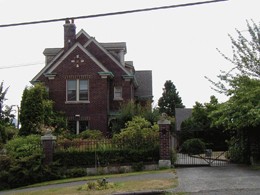On July 27, 1916, the first Birney streetcar (or Birney Safety Car) is put into service in Seattle. The Birney Safety Car is a small, strong, lightweight, electric-rail, inter/intra-city streetcar that is inexpensive to operate and maintain. It is one of the first designs for single-man operation, and is at first dubbed the Safety Car (to emphasize that it is safe, even without a conductor). But the riding public will quickly begin calling it the “Birney Car,” named for its designer, Charles O. Birney (1867-1939). Birney works for the Seattle Electric Company, a subsidiary of the Stone & Webster electricity conglomerate of Boston. Six thousand Birney Cars will be built and operated in cities throughout the United States and Canada.
The Lure of Gold
Prior to going to work for the Stone & Webster firm, Birney, who was still a young man at the age of 30, was lured by the Klondike Gold Rush. In 1897 he made his way to Alaska, and from there to the Klondike River gold fields, where he struck it rich. He returned to Seattle, invested all his money in new claims and returned to the Klondike.
The second trip proved disastrous, as none of the claims produced gold. Birney returned to Seattle to look for work. He later explained, "I had a wife with two children and $2.00. Stone & Webster paid me $2.50 a day and I had to borrow tools" (Stone and Webster).
By the age of 48, Birney had worked for Stone & Webster’s Seattle Electric Company for 17 years. He was ready and primed when asked to create a streetcar capable of competing economically with the jitneys. Jitneys, automobile versions of mass transit operations, were being introduced and seriously competed with electric streetcars, which ran on rails.
Charles Birney, working in tandem with J. M. Bosenburry of the Illinois Traction System, came up with a way to build a new streetcar of lightweight, strong steel construction. The Birney one-man car, built by American Car Company of St. Louis and introduced on Puget Sound railways in 1916, received high marks from the Electric Railway Journal. It wasn’t long before the concept was setting the trend for all future public rail transportation, including numerous Interurban Light-rails commonly seen in America’s larger cities today.
The Edison of Streetcars
After final improvements, the 29-passenger Birney safety car, weighing about 13,000 pounds, cut energy consumption in half and brought a 51.1 percent increase in earnings. More than 6,000 Birney cars rolled out of shops of several manufacturers and onto the streets of North America. The Philadelphia-based Brill Co. built the last new Birney car in 1941. With the exception of one car operated part-time by the Fort Collins Municipal Railway, the only original cars in service in 2004 are in museums. Some Birney replicas that are wheelchair accessible continue in regular service.
In 1928, Birney appeared at the age of 61 before the American Electric Railway Association convention. He was honored as the "Edison of the street railway industry" (Stone and Webster). The Birney car, by then, had become synonymous with safety and economy for a dozen years.
After his retirement from Stone & Webster, in 1930, he and his wife Carlotta chose to live in San Diego, California. In 1938, he returned to Seattle, where he experienced poor health until his death in 1939. Carlotta left the Seattle residence on Queen Anne Hill at 369 Galer Street and moved back to San Diego to join her children and grandchildren.

